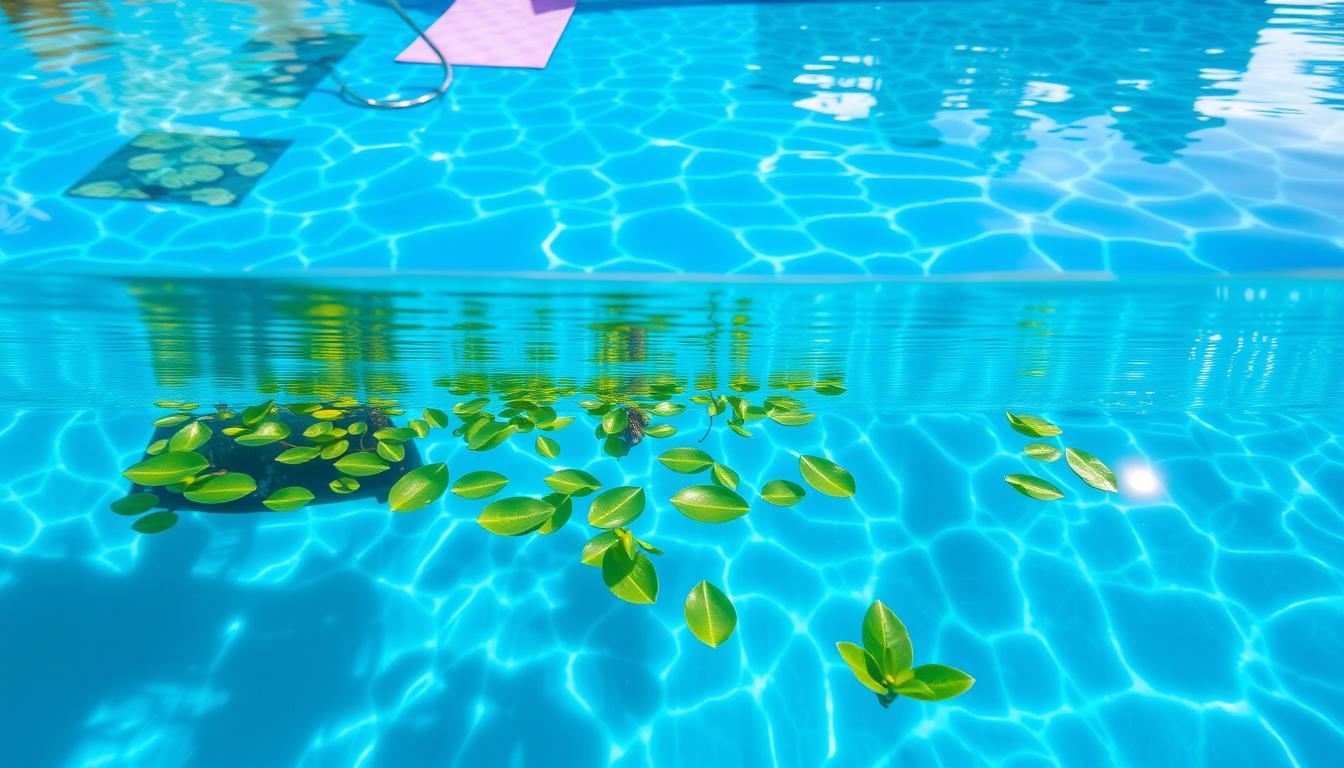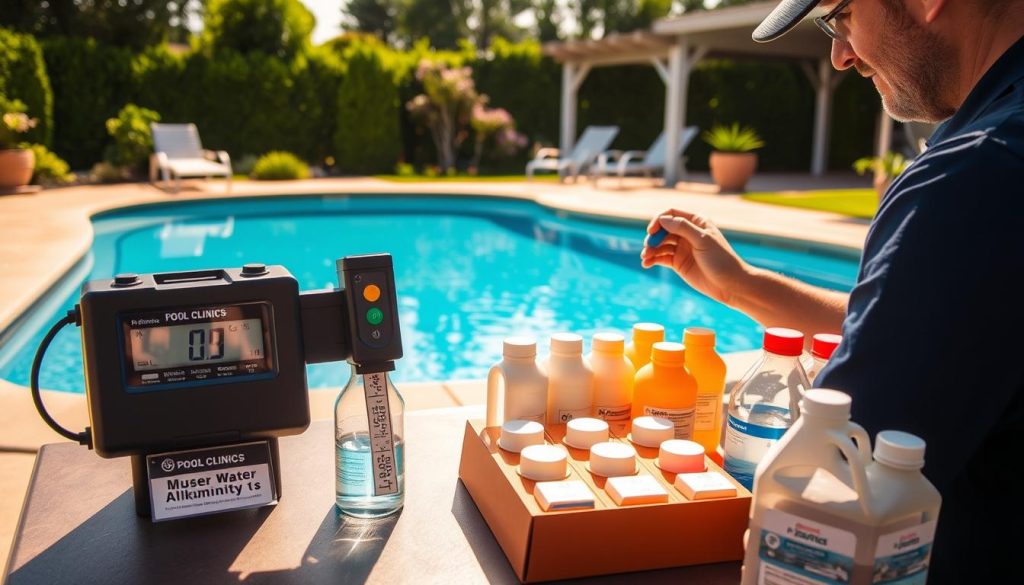
Pool owners aim to create a safe and fun swimming environment. Alkalinity is a crucial aspect of pool water chemistry. Proper alkalinity levels ensure clear water, comfortable swimming, and long-lasting pool equipment.
Have you experienced burning eyes or irritated skin after swimming? Maybe you’ve noticed cloudy pool water. These issues often stem from imbalanced alkalinity levels.
By maintaining the right alkalinity range, we can avoid these problems. This ensures a crystal-clear, inviting pool throughout the season.
Let’s explore pool alkalinity’s function and importance. We’ll discuss steps to keep pools perfectly balanced. Understanding alkalinity is key for both new and experienced pool owners.
This knowledge helps create a safe and enjoyable swimming experience. It’s essential for maintaining a healthy pool environment.
Key Takeaways
- Alkalinity plays a vital role in stabilizing pH levels and maintaining pool water balance.
- The ideal range for total alkalinity in pools is between 80 and 120 parts per million (ppm).
- Imbalanced alkalinity can lead to cloudy water, skin and eye irritation, and corrosion of pool equipment.
- Regular testing and adjusting of alkalinity levels is essential for maintaining a healthy pool environment.
- Proper alkalinity balance contributes to water clarity, swimmer comfort, effective sanitization, and the longevity of pool surfaces and equipment.
What is Pool Alkalinity?
Pool alkalinity measures the water’s ability to neutralize acids and maintain stable pH levels. It acts as a buffer against sudden pH changes. These changes can cause corrosion, scaling, and discomfort for swimmers.
Alkalinity is crucial for overall pool health and balance. It helps prevent various issues that can arise from pH fluctuations.

Defining Alkalinity in Pool Water
Pool alkalinity is the level of alkaline substances, mainly bicarbonates, in the water. These substances neutralize acids from rainwater, swimmer waste, and chemical additives. The ideal alkalinity range for pools is 80 to 120 parts per million (ppm).
Maintaining this range ensures a stable and balanced pool environment. It’s essential for the comfort of swimmers and the longevity of pool equipment.
| Alkalinity Level | Effects on Pool Water |
|---|---|
| Too Low (below 80 ppm) | Acidic water, rapid pH swings, corrosion of pool equipment and surfaces |
| Ideal Range (80-120 ppm) | Stable pH levels, comfortable for swimmers, effective sanitization |
| Too High (above 120 ppm) | Alkaline water, cloudy appearance, scaling on pool surfaces and equipment |
The Relationship Between Alkalinity and pH
Alkalinity and pH are related but different. pH measures water acidity or basicity on a 0-14 scale. Alkalinity refers to the water’s ability to resist pH changes.
Balanced alkalinity helps maintain a stable pH between 7.2 and 7.8. This range is ideal for swimmer comfort and effective sanitization.
“Alkalinity is like a safety net for your pool’s pH. It helps to prevent sudden shifts in pH levels, which can cause a variety of problems for both swimmers and the pool itself.”
Regularly test both alkalinity and pH levels using a reliable test kit or strips. Keeping alkalinity between 80-120 ppm creates a stable pool environment.
This range promotes crystal-clear water, swimmer comfort, and long-lasting pool equipment. It’s key to maintaining a healthy and enjoyable pool.
The Importance of Balanced Total Alkalinity (TA)
Balanced Total Alkalinity (TA) is vital for pool water maintenance. It stabilizes pH levels, affecting water clarity, comfort, and sanitizer effectiveness. TA also impacts pool equipment longevity and surface condition.
Water Clarity and Stability
Balanced TA keeps water clear by preventing pH changes. It acts as a buffer, absorbing acids and bases. This stability enhances filtration, resulting in crystal-clear, inviting water.
Swimmer Comfort and Safety
Stable pH, maintained by balanced TA, ensures swimmer comfort and safety. Low pH causes skin irritation and metal corrosion. High pH leads to scaling and reduced chlorine effectiveness.
Balanced TA keeps swimmers comfortable without adverse effects. It prevents skin dryness and eye discomfort, ensuring a safe swimming experience.
Effective Sanitization
Balanced TA is crucial for pool sanitizers like chlorine. Proper pH allows chlorine to work effectively against harmful bacteria and viruses. High alkalinity can hinder sanitizer effectiveness, leading to unsanitary water conditions.
| Parameter | Ideal Range | Effects of Imbalance |
|---|---|---|
| pH | 7 – 7.4 | Corrosion, scaling, reduced chlorine effectiveness |
| Total Alkalinity (TA) | 80 – 120 ppm | pH instability, scaling risks |
| Hydrotimetric Titer (TH) | 15 – 30 °f | Soft, aggressive water or hard water causing scaling |
Protecting Pool Equipment and Surfaces
Imbalanced TA can damage pool equipment and surfaces. Low alkalinity causes corrosion of metal parts like ladders and handrails. High TA leads to scaling, reducing heating system efficiency.
Maintaining balanced TA protects your pool investment. It ensures your pool stays in excellent condition for years to come.
Clearwater Pool Systems offers innovative solutions like pH Pure™, MineralPURE®, and OzoneMAX™ to help maintain balanced TA and minimize the need for harsh chemicals, ensuring a healthier and more enjoyable swimming experience.
Maintaining Balanced Pool Alkalinity
Balanced alkalinity levels keep your pool water healthy and clear. Regular testing and adjustments are essential. Let’s explore how to test and adjust alkalinity in your pool.
Testing Alkalinity Levels
Test your pool water weekly using a reliable kit or strips. The ideal total alkalinity range is 80-120 parts per million (ppm). If levels are outside this range, adjustments are necessary.
Adjusting Total Alkalinity
To raise low alkalinity, add sodium bicarbonate to the water. Use 1.5 pounds per 10,000 gallons to increase alkalinity by 10 ppm. Always follow the manufacturer’s instructions for precise dosing.
For high alkalinity, carefully add muriatic acid or sodium bisulfate. Follow product directions and safety guidelines when handling these chemicals. Retest after 6-8 hours to ensure levels have stabilized.
What Does Alkalinity Do in a Pool?
Alkalinity is crucial for your pool’s health and balance. It stabilizes pH levels and prevents rapid fluctuations. This protects swimmers and pool equipment from potential harm.
- Stabilizes pH levels, preventing rapid fluctuations that can cause discomfort for swimmers and damage pool equipment
- Acts as a buffer to resist changes in pH when acids or bases are added to the water
- Helps prevent corrosion of metal components in your pool system
- Ensures the effectiveness of chlorine and other sanitizers in keeping your pool water clean and safe
- Contributes to water clarity and prevents clouding caused by mineral imbalances
| Parameter | Ideal Range | Effects of Imbalance |
|---|---|---|
| Total Alkalinity | 80-120 ppm | Unstable pH, corrosion, cloudy water |
| pH | 7.2-7.8 | Irritation, ineffective sanitization, scaling |
| Calcium Hardness | 200-400 ppm | Corrosion, etching, scaling |
| Chlorine | 1-3 ppm | Inadequate sanitization, algae growth |
Regular alkalinity testing and adjustments create a stable swimming environment. This protects your pool equipment and surfaces from damage. Your pool will be more enjoyable and safer for everyone.
Conclusion
Alkalinity is vital for pool water balance. It prevents sudden pH changes, avoiding issues like skin irritation and equipment damage. Keeping total alkalinity between 80-120 ppm ensures clear, safe, and comfortable water.
Test alkalinity weekly using reliable kits or strips. Low alkalinity? Use baking soda or commercial increasers. High alkalinity? Apply muriatic acid or dry acid. Always follow safety instructions when handling chemicals.
Alkalinity also stabilizes pool water overall. Cyanurate alkalinity from cyanuric acid (CYA) buffers pH reduction in outdoor pools. CYA helps chlorine last longer, making pool maintenance more efficient.
Understanding alkalinity’s role creates a balanced pool care routine. It keeps water clear and inviting. Alkalinity is key to a safe, enjoyable swimming environment.







